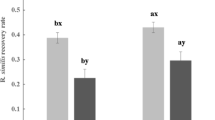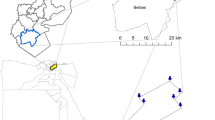Abstract
The rotation of leguminous shrubs and crops is being tested on farms and recommended as a means of improving soil fertility and increasing crop yield in eastern and southern Africa, including western Kenya. However, this improved fallow practice may also increase the nematode population in the soil. An experiment was conducted to monitor the effects of plant-parasitic nematodes on crops after improved fallow. Soil was collected from a maize (Zea mays L.)/bean (Phaseolus vulgaris L.) field, a natural fallow, a Crotalaria (Crotalaria grahamiana Wight & Arn.) fallow, a Tephrosia (Tephrosia vogelii Hook. f.) fallow and a Crotalaria — Tephrosia mixed fallow and used to fill plastic pots placed in a shade. Three successive crop cycles of 2 months were tested in these pots using maize and beans, the most important staple foods in western Kenya. In the first cycle, beans grew poorly on the Tephrosia and Crotalaria — Tephrosia soil due to the high incidence of root knot nematodes, Meloidogyne spp., while maize did not suffer any loss. Although the populations of root knot nematodes reduced drastically in the second and third cycles, both maize and beans experienced heavy losses on the soil under improved fallow probably due to the spiral nematodes, Scutellonema spp., which became dominant in the nematode communities. Despite the use of fertilisers (N, P, K), both crops became highly sensitive to spiral nematodes in the third cycle because of the degradation of the soil physical properties. The study showed that the benefits of improved fallows in terms of crop production may be limited by the high number of plant-parasitic nematodes they help develop in the process.
Similar content being viewed by others
References
Baujard P. and Martiny B. 1995. Ecology and pathogenicity of the Hoplolaimidae (Nemata) from the Sahelian zone of West Africa. 2. Laboratory studies on Scutellonema cavenessi Sher, 1964. Fundamental and Applied Nematology 18: 335–345.
Bongers T. and Bongers M. 1998. Functional diversity of nematodes. Applied Soil Ecology 10: 239–251.
Bridge J., Price N.S. and Kofi P. 1995. Plant parasitic nematodes of plantain and other crops in Cameroon, West Africa. Fundamental and Applied Nematology 18: 335–346.
Cadet P. and Floret C. 1999. Effect of plant parasitic nematodes on the sustainability of a natural fallow cultural system in the Sudano-Sahelian area in Senegal. European Journal of Soil Biology 35: 91–97.
Desaeger J. and Rao M.R. 1999. The root-knot nematode problem in sesbania fallows and scope for managing it in western Kenya. Agroforestry Systems 47: 273–288.
Desaeger J. and Rao M.R. 2000a. Parasitic nematode populations in natural fallows and improved cover crops and their effects on subsequent crops in Kenya. Field Crops Research 65: 41–56.
Desaeger J. and Rao M.R. 2000b. Infection and damage potential of Meloidogyne javanica on Sesbania sesban in different soil types. Nematology 2: 169–178.
ICRAF 1996. Annual Report. International Centre for Research in Agroforestry, Nairobi.
Kandji S.T., Albrecht A. and Ogol C.K.P.O. 2001. Diversity of plant-parasitic nematodes and their relationships with some soil physico-chemical characteristics in improved fallows in western Kenya. Applied Soil Ecology 18: 143–157.
Luc M., Sikora R.A. and Bridge J. 1990. Plant Parasitic Nematodes in Subtropical and Tropical Agriculture. CAB International Institute of Parasitology, Wallingford, UK, 629 pp.
Marshall B., Boag B., Mcnicol J.W. and Neilson R. 1998. A comparison of the spatial distributions of three plant-parasitic nematode species at three different scales. Nematologica 44: 303–320.
McKenry M.V. and Ferris H. 1983. Nematodes. In: Kommendahl T. and Williams P.H. (eds), Challenging Problems in Plant Health. American Phytopathological Society, St Paul, pp. 267–279.
Melakeberhan H. 1997. Plant, nematode and nutrient relations: an overview. Japanese Journal of Nematology 27: 41–51.
Mullin B.A., Abawi G.S., Pastor-Corrales M.A. and Kornegay J.L. 1991. Root-knot nematodes associated with beans in Colombia and Peru and related yield loss. Plant Disease 75: 1208–1211.
Ngundo B.W. and Taylor D.P. 1974. Effects of Meloidogyne spp. on bean yields in Kenya. Plant Disease Reporter 58: 1020–1023.
Nickle W.R. 1991. Manual of Agricultural Nematology. Marcell Dekker Inc, New York, 1020 pp.
Powell N.T. 1971. Interaction of plant parasitic nematodes with other disease causing agents. In: Zuckerman B.M., Mai W.F. and Rohde R.A. (eds), Plant Parasitic Nematodes. Academic Press, New York, pp. 119–136.
Powell N.T. 1979. Internal synergisms among organisms inducing disease. In: Horsfall J.G. and Cowling E.B. (eds), Plant Disease. Academic Press, New York, pp. 113–133.
Rao M.R., Nair P.K.K. and Ong C.K. 1998. Biophysical interactions in tropical agroforestry systems. Agroforestry Systems 38: 30–50.
Sharma S.B., Price N.S. and Bridge J. 1997. The past, present and future of plant nematology in International Agricultural Research Centres. Nematological Abstracts 66(3): 119–142.
Siddiqi M.R. 1986. Tylenchida, Parasites of Plants and Insects. C.A.B. International, Slough, 645 pp.
Simon A. and Rovira A.D. 1985. The influence of phosphate fertilizer on the growth and yield of wheat in soil infested with cereal cyst nematode (Heterodera avenae Woll.). Aust. J. Exp. Agric 25: 191–197.
Taha A.H.Y. 1993. Nematode interactions with root-nodule bacteria. In: Khan M.W. (ed.), Nematode Interactions. Chapman & Hall, London, pp. 175–202.
Wallace H.R. 1983. Interactions between nematodes and other factors on plants. J. Nematol 15: 221–227.
Author information
Authors and Affiliations
Corresponding author
Rights and permissions
About this article
Cite this article
Kandji, S.T., Ogol, C.K. & Albrecht, A. Crop damage by nematodes in improved-fallow fields in western Kenya. Agroforestry Systems 57, 51–57 (2003). https://doi.org/10.1023/A:1022949431814
Issue Date:
DOI: https://doi.org/10.1023/A:1022949431814




